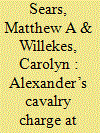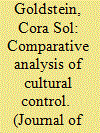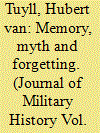|
|
|
Sort Order |
|
|
|
Items / Page
|
|
|
|
|
|
|
| Srl | Item |
| 1 |
ID:
148640


|
|
|
|
|
| Summary/Abstract |
The Battle of Chaeronea, fought in 338 BCE between Philip of Macedon and the Greek city-states, is known only from meager literary evidence and a few archaeological finds. For decades, scholars had reconstructed the battle to include a cavalry charge led by Philip’s eighteen-year-old son, the future Alexander the Great. More recently, this cavalry charge has been called into question, primarily because of the supposed maxim that cavalry will not trample disciplined infantry. A reconsideration of the evidence, however, including skeletal remains from the battle and studies of equine behavior, suggests that Alexander’s charge was feasible.
|
|
|
|
|
|
|
|
|
|
|
|
|
|
|
|
| 2 |
ID:
148643


|
|
|
|
|
| Summary/Abstract |
A transformative military occupation aimed at the radical ideological change of an occupied country must exercise cultural control. The occupiers must complement repression with propaganda and censorship to create new narratives and prohibit those deemed undesirable. Do transformative military occupations carried out by dictatorships and liberal democracies differ in the way in which they handle information control? I argue that the mechanisms of cultural control used by the Third Reich in France (1940–1942) and by the United States in Germany (1945–1949), shared significant similarities in spite of the fact that their respective agendas were inspired by opposite ideological tenets.
|
|
|
|
|
|
|
|
|
|
|
|
|
|
|
|
| 3 |
ID:
148641


|
|
|
|
|
| Summary/Abstract |
The 14-15 October 1880 battle of Tres Castillos in the state of Chihuahua, Mexico, brought a dramatic end to the career of Victorio, one of the greatest military leaders of the Apache peoples of the American Southwest and northern Mexico. This article contends that Victorio’s defeat and death at the hands of Mexican troops at Tres Castillos did not come at the end of aimless wandering in the desert, as has been alleged. It marked, instead, the conclusion of a campaign that epitomized the distinctive strategies and tactics which characterized the Apache way of guerrilla warfare and that are worthy of continued study today.
|
|
|
|
|
|
|
|
|
|
|
|
|
|
|
|
| 4 |
ID:
148642


|
|
|
|
|
| Summary/Abstract |
The Netherlands’ escape from the ‘hard hand of war’ in 1914-1918 was explained until this century through several myths, all of which painted the country as a passive player during the war. That these myths are now discredited is not new. What has been given little attention, however, is the impact of these myths on the Netherlands’ preparation for the next war, which it would not escape. The consequences of the country’s faulty historical memory would have an impact well beyond its own borders.
|
|
|
|
|
|
|
|
|
|
|
|
|
|
|
|
| 5 |
ID:
148644


|
|
|
|
|
| Summary/Abstract |
The recent revival of academic and popular interest in the Korean War in Turkey has played an important role in instigating the production of new books and documentaries. In Turkish accounts the Battle of Kunu-ri (November 1950) figures more prominently than any other event during the entire conflict. However, the Turkish Brigade’s performance at this battle remains controversial. This paper assesses the impact of U.S. military assistance on Turkish military’s transformation, compares and contrasts the official U.S. and Turkish accounts of the battle (known in U.S. sources as the Battle of Chongchon), and discusses why the official perspectives of the engagement diverge substantially.
|
|
|
|
|
|
|
|
|
|
|
|
|
|
|
|
| 6 |
ID:
148645


|
|
|
|
|
| Summary/Abstract |
After the Communist Tet Offensive of 1968, General William Westmoreland, commander of U.S. forces in Vietnam, supposedly credited the Army-Navy Mobile Riverine Force (MRF) with having “saved the [Mekong] Delta” for the allied cause. The MRF drove enemy forces from key population centers and decimated the Viet Cong main force units that stood and fought them. But in August 1969, General Creighton Abrams, Westmoreland’s successor, disbanded the MRF. Despite the MRF’s impressive battle history, Army and Navy leaders never fully embraced the creation, development, or operational deployment of one of the few truly joint-service units of the Vietnam War.
|
|
|
|
|
|
|
|
|
|
|
|
|
|
|
|
| 7 |
ID:
148639


|
|
|
|
|
| Summary/Abstract |
The Battle of Chaeronea, fought in 338 BCE between Philip of Macedon and the Greek city-states, is known only from meager literary evidence and a few archaeological finds. For decades, scholars had reconstructed the battle to include a cavalry charge led by Philip’s eighteen-year-old son, the future Alexander the Great. More recently, this cavalry charge has been called into question, primarily because of the supposed maxim that cavalry will not trample disciplined infantry. A reconsideration of the evidence, however, including skeletal remains from the battle and studies of equine behavior, suggests that Alexander’s charge was feasible.
|
|
|
|
|
|
|
|
|
|
|
|
|
|
|
|
|
|
|
|
|